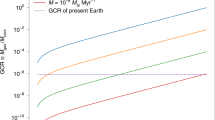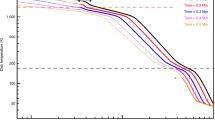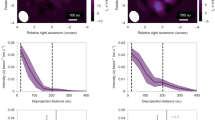Abstract
The chemical reservoir within protoplanetary disks has a direct impact on planetary compositions and the potential for life. A long-lived carbon- and nitrogen-rich chemistry at cold temperatures (≤ 50 K) is observed within cold and evolved planet-forming disks. This is evidenced by bright emission from small organic radicals in 1–10 Myr aged systems that would otherwise have frozen out onto grains within 1 Myr. We explain how the chemistry of a planet-forming disk evolves from a cosmic-ray/X-ray-dominated regime to a ultraviolet-dominated chemical equilibrium. This, in turn, will bring about a temporal transition in the chemical reservoir from which planets will accrete. This photochemical dominated gas phase chemistry develops as dust evolves via growth, settling and drift, and the small grain population is depleted from the disk atmosphere. A higher gas-to-dust mass ratio allows for deeper penetration of ultraviolet photons is coupled with a carbon-rich gas (C/O > 1) to form carbon-bearing radicals and ions. This further results in gas phase formation of organic molecules, which then would be accreted by any actively forming planets present in the evolved disk.
This is a preview of subscription content, access via your institution
Access options
Access Nature and 54 other Nature Portfolio journals
Get Nature+, our best-value online-access subscription
$29.99 / 30 days
cancel any time
Subscribe to this journal
Receive 12 digital issues and online access to articles
$119.00 per year
only $9.92 per issue
Buy this article
- Purchase on Springer Link
- Instant access to full article PDF
Prices may be subject to local taxes which are calculated during checkout




Similar content being viewed by others
Data availability
The data that support the findings of this study can be obtained as part of the MAPS programme and are publicly available via alma-maps.info. This paper makes use of the following ALMA data: ADS/JAO.ALMA#2018.1.01055.L. and 2016.1.01046.S. Data regarding TW Hya can be obtained via data-rich figures in the online version of ref. 58. ALMA is a partnership of European Southern Observatory (ESO) (representing its member states), NSF (USA) and National Institutes of Natural Sciences (Japan), together with National Research Council (Canada), Ministry of Science and Technology and Academia Sinica Insitute of Astronomy and Astrophysics (Taiwan), and Korea Astronomy and Space Science Insitute (Republic of Korea), in cooperation with the Republic of Chile. The Joint ALMA Observatory is operated by ESO, Associated Universities Inc/National Radio Astronomy Observatory and National Astronomical Observatory of Japan. The National Radio Astronomy Observatory is a facility of the National Science Foundation operated under cooperative agreement by Associated Universities, Inc.
Code availability
This study relied on the following publicly available coding packages: rac2d https://github.com/fjdu/rac-2d, RADMC-3D https://www.ita.uni-heidelberg.de/~dullemond/software/radmc-3d/ and GoFish https://github.com/richteague/gofish. TORUS is a private code developed by T. Harries and collaborators.
References
Miotello, A., Kamp, I., Birnstiel, T., Cleeves, L. I. & Kataoka, A. Setting the stage for planet formation: measurements and implications of the fundamental disk properties. Preprint at arXiv:2203.09818 (2022). https://arxiv.org/abs/2203.09818
Ansdell, M. et al. ALMA survey of Lupus protoplanetary disks. II. Gas disk radii. Astrophys. J. 859, 21 (2018).
Haisch Jr, K. E., Lada, E. A. & Lada, C. J. Disk frequencies and lifetimes in young clusters. Astrophys. J. Lett. 553, L153–L156 (2001).
Andrews, S. M. & Birnstiel, T. in Handbook of Exoplanets (eds. Deeg, H. J. & Belmonte, J. A.) 136 (Springer International Publishing AG, 2018).
Öberg, K. I., Murray-Clay, R. & Bergin, E. A. The effects of snowlines on C/O in planetary atmospheres. Astrophys. J. Lett. 743, L16 (2011).
Johansen, A. & Lambrechts, M. Forming planets via pebble accretion. Annu. Rev. Earth Planet. Sci. 45, 359–387 (2017).
Lambrechts, M., Johansen, A. & Morbidelli, A. Separating gas-giant and ice-giant planets by halting pebble accretion. Astron. Astrophys. 572, A35 (2014).
Powner, M. W., Gerland, B. & Sutherland, J. D. Synthesis of activated pyrimidine ribonucleotides in prebiotically plausible conditions. Nature 459, 239–242 (2009).
Ritson, D. & Sutherland, J. D. Prebiotic synthesis of simple sugars by photoredox systems chemistry. Nat. Chem. 4, 895–899 (2012).
Sutherland, J. D. The origin of life - out of the blue. Angew. Chem. 55, 104–121 (2015).
Bergner, J. B., Guzmán, V. G., Öberg, K. I., Loomis, R. A. & Pegues, J. A survey of CH3CN and HC3N in protoplanetary disks. Astrophys. J. 857, 69 (2018).
Ilee, J. D. et al. Molecules with ALMA at Planet-forming Scales (MAPS). IX. Distribution and properties of the large organic molecules HC3N, CH3CN, and c-C3H2. Astrophys. J. Suppl. Ser. 257, 9 (2021).
Kastner, J. H. et al. A subarcsecond ALMA Molecular Line Imaging Survey of the circumbinary, protoplanetary disk orbiting V4046 Sgr. Astrophys. J. 863, 106 (2018).
Öberg, K. I. et al. The comet-like composition of a protoplanetary disk as revealed by complex cyanides. Nature 520, 198–201 (2015).
Loomis, R. A. et al. The distribution and excitation of CH3CN in a solar nebula analog. Astrophys. J. 859, 131 (2018).
Chapillon, E. et al. Chemistry in disks. VII. First detection of HC3N in protoplanetary disks. Astrophys. J. 756, 58 (2012).
Goldsmith, P. F. & Langer, W. D. Population diagram analysis of molecular line emission. Astrophys. J. 517, 209–225 (1999).
Corazzi, M. A. et al. Thermal desorption of astrophysically relevant ice mixtures of acetaldehyde and acetonitrile from olivine dust. Astrophys. J. 913, 128 (2021).
Canta, A., Teague, R., Le Gal, R. & Öberg, K. I. The first detection of CH2CN in a protoplanetary disk. Astrophys. J. 922, 62 (2021).
Öberg, K. I. et al. The Spitzer ice legacy: ice evolution from cores to protostars. Astrophys. J. 740, 109 (2011).
Bergner, J. B. & Ciesla, F. Ice inheritance in dynamical disk models. Astrophys. J. 919, 45 (2021).
Walsh, C. et al. Complex organic molecules in protoplanetary disks. Astron. Astrophys. 563, A33 (2014).
Vasyunin, A. I. & Herbst, E. Reactive desorption and radiative association as possible drivers of complex molecule formation in the cold interstellar medium. Astrophys. J. 769, 34 (2013).
Basalgète, R. et al. Photodesorption of acetonitrile CH3CN in UV-irradiated regions of the interstellar medium: experimental evidence. Astrophys. J. 922, 213 (2021).
Miotello, A. et al. Bright C2H emission in protoplanetary discs in Lupus: high volatile C/O > 1 ratios. Astron. Astrophys. 631, A69 (2019).
Bosman, A. D. et al. Molecules with ALMA at Planet-forming Scales (MAPS). VII. Substellar O/H and C/H and superstellar C/O in planet-feeding gas. Astrophys. J. Suppl. Ser. 257, 7 (2021).
Cleeves, L. I. et al. The TW Hya Rosetta Stone Project IV: a hydrocarbon-rich disk atmosphere. Astrophys. J. 911, 29 (2021).
Le Gal, R., Brady, M. T., Öberg, K. I., Roueff, E. & Le Petit, F. The role of C/O in nitrile astrochemistry in PDRs and planet-forming disks. Astrophys. J. 886, 86 (2019).
Asplund, M., Amarsi, A. M. & Grevesse, N. The chemical make-up of the Sun: a 2020 vision. Astron. Astrophys. 653, A141 (2021).
Law, C. J. et al. Molecules with ALMA at Planet-forming Scales (MAPS). IV. Emission surfaces and vertical distribution of molecules. Astrophys. J. Suppl. Ser. 257, 4 (2021).
Birnstiel, T., Andrews, S. M. & Ercolano, B. Can grain growth explain transition disks? Astron. Astrophys. 544, A79 (2012).
Öberg, K. I. et al. Molecules with ALMA at Planet-forming Scales (MAPS). I. Program overview and highlights. Astrophys. J. Suppl. Ser. 257, 1 (2021).
Bergner, J. B. et al. A survey of C2H, HCN, and C18O in protoplanetary disks. Astrophys. J. 876, 25 (2019).
Gaia Collaboration. Gaia Data Release 2. Summary of the contents and survey properties. Astron. Astrophys. 616, A1 (2018).
Booth, A. S. et al. Molecules with ALMA at Planet-forming Scales (MAPS). XVI. Characterizing the impact of the molecular wind on the evolution of the HD 163296 system. Astrophys. J. Suppl. Ser. 257, 16 (2021).
Xie, C. et al. A MUSE view of the asymmetric jet from HD 163296. Astron. Astrophys. 650, L6 (2021).
Andrews, S. M. et al. The Disk Substructures at High Angular Resolution Project (DSHARP). I. Motivation, sample, calibration, and overview. Astrophys. J. Lett. 869, L41 (2018).
Bergner, J. B. et al. Molecules with ALMA at Planet-forming Scales (MAPS). XI. CN and HCN as tracers of photochemistry in disks. Astrophys. J. Suppl. Ser. 257, 11 (2021).
Zhang, K. et al. Molecules with ALMA at Planet-forming Scales (MAPS). V. CO gas distributions. Astrophys. J. Suppl. Ser. 257, 5 (2021).
Calahan, J. K. et al. Molecules with ALMA at Planet-forming Scales (MAPS). XVII. Determining the 2D thermal structure of the HD 163296 disk. Astrophys. J. Suppl. Ser. 257, 17 (2021).
Bosman, A. D., Alarcón, F., Zhang, K. & Bergin, E. A. Destruction of refractory carbon grains drives the final stage of protoplanetary disk chemistry. Astrophys. J. 910, 3 (2021).
Schwarz, K. R. et al. Unlocking CO depletion in protoplanetary disks. I. The warm molecular layer. Astrophys. J. 856, 85 (2018).
Krijt, S., Schwarz, K. R., Bergin, E. A. & Ciesla, F. J. Transport of CO in protoplanetary disks: consequences of pebble formation, settling, and radial drift. Astrophys. J. 864, 78 (2018).
Van Clepper, E., Bergner, J. B., Bosman, A. D., Bergin, E. & Ciesla, F. J. Chemical feedback of pebble growth: impacts on CO depletion and C/O ratios. Astrophys. J. 927, 206 (2022).
Bosman, A. D., Walsh, C. & van Dishoeck, E. F. CO destruction in protoplanetary disk midplanes: Inside versus outside the CO snow surface. Astron. Astrophys. 618, A182 (2018).
McElroy, D. et al. The UMIST database for astrochemistry 2012. Astron. Astrophys. 550, A36 (2013).
Najita, J. R., Ádámkovics, M. & Glassgold, A. E. Formation of organic molecules and water in warm disk atmospheres. Astrophys. J. 743, 147 (2011).
Anderson, D. E. et al. Observing carbon and oxygen carriers in protoplanetary disks at mid-infrared wavelengths. Astrophys. J. 909, 55 (2021).
Woitke, P., Kamp, I. & Thi, W. F. Radiation thermo-chemical models of protoplanetary disks. I. Hydrostatic disk structure and inner rim. Astron. Astrophys. 501, 383–406 (2009).
Brewer, J. M., Fischer, D. A. & Madhusudhan, N. C/O and O/H ratios suggest some hot Jupiters originate beyond the snow line. Astron. J. 153, 83 (2017).
Gammie, C. F. & Ostriker, E. C. Can nonlinear hydromagnetic waves support a self-gravitating cloud? Astrophys. J. 466, 814 (1996).
Czekala, I. et al. Molecules with ALMA at Planet-forming Scales (MAPS). II. CLEAN strategies for synthesizing images of molecular line emission in protoplanetary disks. Astrophys. J. Suppl. Ser. 257, 2 (2021).
Law, C. J. et al. Molecules with ALMA at Planet-forming Scales (MAPS). III. Characteristics of radial chemical substructures. Astrophys. J. Suppl. Ser. 257, 3 (2021).
McMullin, J. P., Waters, B., Schiebel, D., Young, W. & Golap, K. in Astronomical Data Analysis Software and Systems XVI, Vol. 376 of Astronomical Society of the Pacific Conference Series (eds. Shaw, R. A. et al.) 127 (Astronomical Society of the Pacific, 2007).
Jorsater, S. & van Moorsel, G.A. High resolution neutral hydrogen observations of the barred spiral galaxy NGC 1365. Astron. J. 110, 2037 (1995).
Du, F. & Bergin, E. A. Water vapor distribution in protoplanetary disks. Astrophys. J. 792, 2 (2014).
Dullemond, C. P. et al. RADMC-3D: A multi-purpose radiative transfer tool (Astrophysics Source Code Library, 2012).
Calahan, J. K. et al. The TW Hya Rosetta Stone Project. III. Resolving the gaseous thermal profile of the disk. Astrophys. J. 908, 8 (2021).
Lynden-Bell, D. & Pringle, J. E. The evolution of viscous discs and the origin of the nebular variables. Mon. Not. R. Astron. Soc. 168, 603–637 (1974).
Mathis, J. S., Rumpl, W. & Nordsieck, K. H. The size distribution of interstellar grains. Astrophys. J. 217, 425–433 (1977).
Isella, A. et al. The Disk Substructures at High Angular Resolution Project (DSHARP). IX. A High-definition study of the HD 163296 planet-forming disk. Astrophys. J. Lett. 869, L49 (2018).
Birnstiel, T. et al. The Disk Substructures at High Angular Resolution Project (DSHARP). V. Interpreting ALMA maps of protoplanetary disks in terms of a dust model. Astrophys. J. Lett. 869, L45 (2018).
Warren, S. G. & Brandt, R. E. Optical constants of ice from the ultraviolet to the microwave: a revised compilation. J. Geophys. Res. (Atmos.) 113, D14220 (2008).
Draine, B. T. Interstellar dust grains. Annu. Rev. Astron. Astrophys. 41, 241–289 (2003).
Henning, T. & Stognienko, R. Dust opacities for protoplanetary accretion disks: influence of dust aggregates. Astron. Astrophys. 311, 291–303 (1996).
Schöier, F. L., van der Tak, F. F. S., van Dishoeck, E. F. & Black, J. H. An atomic and molecular database for analysis of submillimetre line observations. Astron. Astrophys. 432, 369–379 (2005).
Müller, H. S. P., Thorwirth, S., Roth, D. A. & Winnewisser, G. The Cologne Database for Molecular Spectroscopy, CDMS. Astron. Astrophys. 370, L49–L52 (2001).
Müller, H. S. P., Schlöder, F., Stutzki, J. & Winnewisser, G. The Cologne Database for Molecular Spectroscopy, CDMS: a useful tool for astronomers and spectroscopists. J. Mol. Struct. 742, 215–227 (2005).
Teague, R. Gofish: Fishing for line observations in protoplanetary disks. J. Open Source Softw. 4, 1632 (2019).
Allen, M. & Robinson, G. W. The molecular composition of dense interstellar clouds. Astrophys. J. 212, 396–415 (1977).
Hasegawa, T. I., Herbst, E. & Leung, C. M. Models of gas-grain chemistry in dense interstellar clouds with complex organic molecules. Astrophys. J. Suppl. Ser. 82, 167 (1992).
Goumans, T. P. M., Uppal, M. A. & Brown, W. A. Formation of CO2 on a carbonaceous surface: a quantum chemical study. Mon. Not. R. Astron. Soc. 384, 1158–1164 (2008).
Ioppolo, S., Cuppen, H. M., Romanzin, C., van Dishoeck, E. F. & Linnartz, H. Laboratory evidence for efficient water formation in interstellar ices. Astrophys. J. 686, 1474–1479 (2008).
Ioppolo, S., Cuppen, H. M., Romanzin, C., van Dishoeck, E. F. & Linnartz, H. Water formation at low temperatures by surface O2 hydrogenation I: characterization of ice penetration. Phys. Chem. Chem. Phys.12, 12065 (2010).
Fuchs, G. W. et al. Hydrogenation reactions in interstellar CO ice analogues. A combined experimental/theoretical approach. Astron. Astrophys. 505, 629–639 (2009).
Oba, Y. et al. Water formation through a quantum tunneling surface reaction, OH + H2, at 10 K. Astrophys. J. 749, 67 (2012).
Ruffle, D. P. & Herbst, E. New models of interstellar gas-grain chemistry – III. Solid CO2. Mon. Not. R. Astron. Soc. 324, 1054–1062 (2001).
Bergner, J. B., Rajappan, M. & Öberg, K. I. HCN snow lines in protoplanetary disks: constraints from ice desorption experiments. Astrophys. J. 933, 206 (2022).
Guzmán, V. V. et al. Molecules with ALMA at Planet-forming Scales (MAPS). VI. Distribution of the small organics HCN, C2H, and H2CO. Astrophys. J. Suppl. Ser. 257, 6 (2021).
Acknowledgements
J.K.C. acknowledges support from the National Science Foundation Graduate Research Fellowship under grant no. DGE 1256260 and the National Aeronautics and Space Administration FINESST grant, under grant no. 80NSSC19K1534. E.A.B. acknowledges support from National Science Foundation (NSF) AAG grant no. 1907653. A.D.B. acknowledges support from NSF AAG grant no. 1907653. E.A.R. acknowledges support from NSF AST grant no. 1830728. J.B.B. acknowledges support from NASA through the NASA Hubble Fellowship grant no. HST-HF2-51429.001-A, awarded by the Space Telescope Science Institute, which is operated by the Association of Universities for Research in Astronomy, Inc., for NASA, under contract NAS5-26555. Support for J.H. was provided by NASA through the NASA Hubble Fellowship grant no. HST-HF2-51460.001-A awarded by the Space Telescope Science Institute, which is operated by the Association of Universities for Research in Astronomy, Inc., for NASA, under contract no. NAS5-26555. This work was supported by a grant from the Simons Foundation 686302 and by an award from the Simons Foundation 321183FY19 (to K.I.Ö.). This material is based upon work supported by the National Science Foundation under grant no. AST-1907832. J.D.I. acknowledges support from an STFC Ernest Rutherford Fellowship (no. ST/W004119/1) and a University Academic Fellowship from the University of Leeds. C.W. acknowledges financial support from the University of Leeds, the Science and Technology Facilities Council and UK Research and Innovation (grant nos. ST/T000287/1 and MR/T040726/1). V.V.G. gratefully acknowledges support from FONDECYT Regular 1221352, ANID BASAL projects nos. ACE210002 and FB210003, and ANID – Millennium Science Initiative Program – NCN19_171. We thank T. Harries for help with and providing access to the TORUS modelling program.
Author information
Authors and Affiliations
Contributions
J.K.C. is the lead author, produced thermochemical models and led the group effort to put forward this new chemical theory. E.A.B. contributed to the text, provided advisement throughout the modelling process, contributed heavily to the scientific theory, and is a principle investigator of the large observing programme these models and theory rely on. A.D.B contributed to the text, provided advisement throughout the modelling process, and contributed heavily to the scientific theory and the SED modelling. E.A.R. contributed to the text and provided and contributed to the SED modelling. K.I.Ö. and V.V.G. contributed to the text and discussion on the scientific theory, and are principle investigators of the large observing programme these models and theory rely on. C.W. contributed to the text and discussion on the scientific theory, compiled the gas-grain chemical network and is a PI of the large observing programme these models and theory rely on. S.M.A., J.B.B., L.I.C., J.H., J.D.I., C.J.L, R.LG., R.T., D.J.W. and K.Z. contributed significantly to discussion of the theory and writing and editing of the text.
Corresponding author
Ethics declarations
Competing interests
The authors declare no competing interests
Peer review
Peer review information
Nature Astronomy thanks Maria Drozdovskaya and the other, anonymous, reviewer(s) for their contribution to the peer review of this work.
Additional information
Publisher’s note Springer Nature remains neutral with regard to jurisdictional claims in published maps and institutional affiliations.
Supplementary information
Supplementary Information
Supplementary Discussion, Figs. 1–7 and references.
Rights and permissions
Springer Nature or its licensor (e.g. a society or other partner) holds exclusive rights to this article under a publishing agreement with the author(s) or other rightsholder(s); author self-archiving of the accepted manuscript version of this article is solely governed by the terms of such publishing agreement and applicable law.
About this article
Cite this article
Calahan, J.K., Bergin, E.A., Bosman, A.D. et al. UV-driven chemistry as a signpost of late-stage planet formation. Nat Astron 7, 49–56 (2023). https://doi.org/10.1038/s41550-022-01831-8
Received:
Accepted:
Published:
Issue Date:
DOI: https://doi.org/10.1038/s41550-022-01831-8



